High-quality air ionization showers combine HEPA filtration with bipolar ionization technology to give you maximum contamination control. You'll achieve up to 99.97% removal of particles larger than 0.3 μm, with ionization boosting efficiency to 92%. The best systems feature electronic interlocking, pressure differentials, and closed-loop air circulation for ISO Class 5 or lower cleanliness standards. While prices range from 2,000 to 20,000 yuan, you'll benefit from reduced maintenance costs and improved air quality. With multiple configurations and features like UVC sterilization available, understanding your specific needs will help determine the ideal solution.
Understanding Air Shower Technology
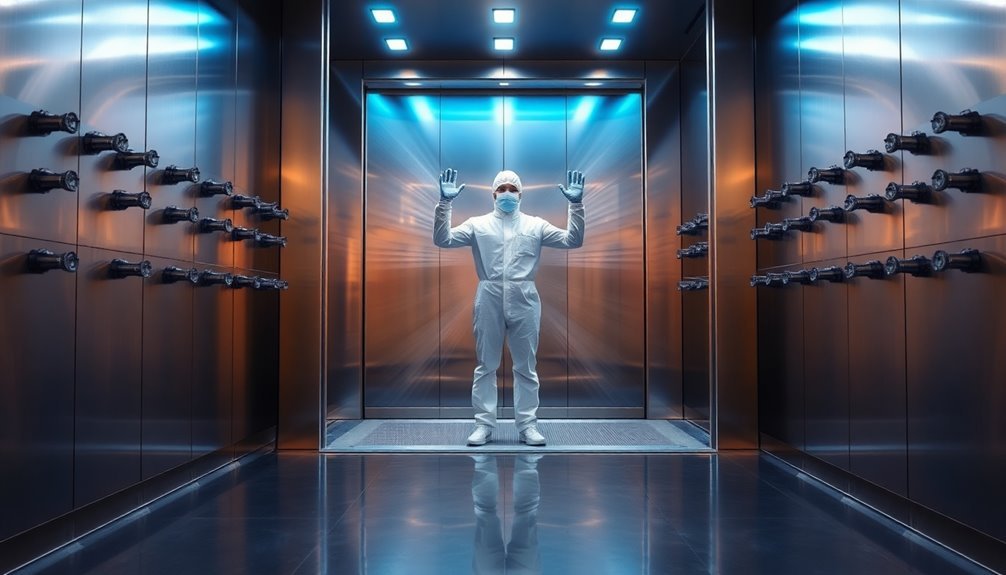
Anyone who's worked in a cleanroom environment knows the importance of air showers.
These essential systems use high-pressure, HEPA- or ULPA-filtered air to remove dust and contaminants from your clothing and equipment before you enter sensitive areas.
Similar to advanced Air-Powered™ shower technology, these systems maximize efficiency while maintaining powerful performance.
You'll find they're particularly critical in facilities requiring ISO Class 5 or lower cleanliness standards, such as microelectronics and semiconductor manufacturing plants.
When you step into an air shower, you'll experience a 30-45 second cycle of continuous air streaming from jet nozzles.
The system operates on a closed-loop principle, ensuring you're only exposed to decontaminated air.
You'll notice the presence of air ionizers, which work to reduce static electricity that could otherwise attract and hold particles to your clothing.
The technology's effectiveness is impressive – you can expect removal of 99.97% of particles larger than 0.3 μm.
Modern air showers feature interlocking doors to maintain environment control, and some advanced models are even door-less for higher processing capacity.
You'll find them strategically placed between gowning areas and cleanrooms or between spaces with different ISO ratings, ensuring maximum contamination control.
Key Features of Ionization Showers
You'll find ionization showers equipped with powerful cleansing capabilities that effectively remove particles ranging from 0.3 μm to larger contaminants through their advanced ion distribution technology.
The showers use bipolar ionization systems to create dense ion fields that charge particles both positively and negatively, ensuring thorough particle capture and removal throughout the entire chamber. The innovative door-less design contributes to a remarkable 92% dust removal rate while preventing contamination leakage.
Built-in safety mechanisms, including emergency stops and pressure differential monitoring, protect you while maintaining peak performance and preventing contamination leakage.
Cleansing Power and Range
Ionized air showers stand out for their remarkable cleansing capabilities, offering up to 92% dust removal efficiency compared to conventional air showers' 50% rate.
You'll find their effectiveness stems from advanced ionization processes that break down electrostatic bonds between particles and surfaces, making containment removal considerably more thorough. The high voltage DC energizes specialized wires to create powerful ionization fields.
These systems work through bipolar ionization, where particles receive opposite charges, causing them to bond and fall from the air. The technology extends from head to shoe soles, ensuring extensive cleaning that you won't get with standard air blow-offs.
You can rely on these systems for various applications, from cleaning cleanroom garments to purifying incoming materials.
You'll appreciate the versatility of ionized air showers across different fabric types, including polyester and Gortex. They're particularly effective in maintaining contamination control in changing rooms and preventing dust from entering cleanrooms.
With particle effectiveness down to 0.01 microns and coverage areas up to 800 sq. ft., you're getting superior air purification while consuming minimal power – typically less than 4 watts.
The systems operate safely, maintaining ozone levels well below OSHA standards.
Ion Distribution Technology
Building on the advanced cleansing capabilities, the ion distribution technology behind these air showers operates through a sophisticated molecular process. You'll find that these systems create both positive and negative ions from water vapor molecules in the air, specifically targeting hydrogen and oxygen components. As these ions disperse throughout your space, they'll actively cluster around unwanted particles, making them easier to filter out.
When you install an air ionization shower, you'll benefit from its versatile distribution methods. Operating at 2800 CFM capacity, these powerful systems deliver exceptional air movement throughout your space. You can choose between ducted systems that integrate with your existing HVAC infrastructure or standalone units that work independently. The technology effectively disperses ions throughout your environment, attaching to airborne contaminants through agglomeration.
You'll notice that the distribution system doesn't just clean the air – it also tackles surface contamination. The ions neutralize electrostatically charged surfaces, helping to remove stubborn particles more effectively than traditional air blow-offs.
This dual-action approach means you're getting extensive protection, as the technology eliminates up to 99.7% of airborne and surface pathogens without producing harmful ozone. The system's efficiency in distributing ions guarantees consistent air quality improvement throughout your space.
Built-in Safety Mechanisms
Safety features stand at the forefront of modern air ionization shower design. When you're selecting an air ionization shower, you'll find several critical safety mechanisms that protect both personnel and the controlled environment.
Electronic interlocking mechanisms prevent simultaneous door openings, while pressure differentials create effective barriers between internal and external environments.
You'll benefit from multiple layers of protection, including emergency stops that allow immediate system shutdown and air ionization systems that reduce potentially damaging static electricity.
The closed-loop air system guarantees you're working with thoroughly decontaminated air while preventing contaminated air from escaping into clean areas. Operating at air velocities ranging from 3,000 to 7,000 feet per minute ensures thorough decontamination.
Built-in sensors activate the air jets and control decontamination cycles automatically, taking the guesswork out of operation.
You'll also find sophisticated alarm systems that alert you to any system failures, while HEPA/ULPA filtration removes 99.97% of particles larger than 0.3 μm.
These safety features work together with ISO-classified interchange vestibules to maintain cleanroom integrity.
To guarantee these safety mechanisms remain effective, you'll need to follow regular maintenance schedules and conduct routine inspections.
It's crucial to participate in training programs that cover proper usage and emergency procedures.
Installation and Space Requirements
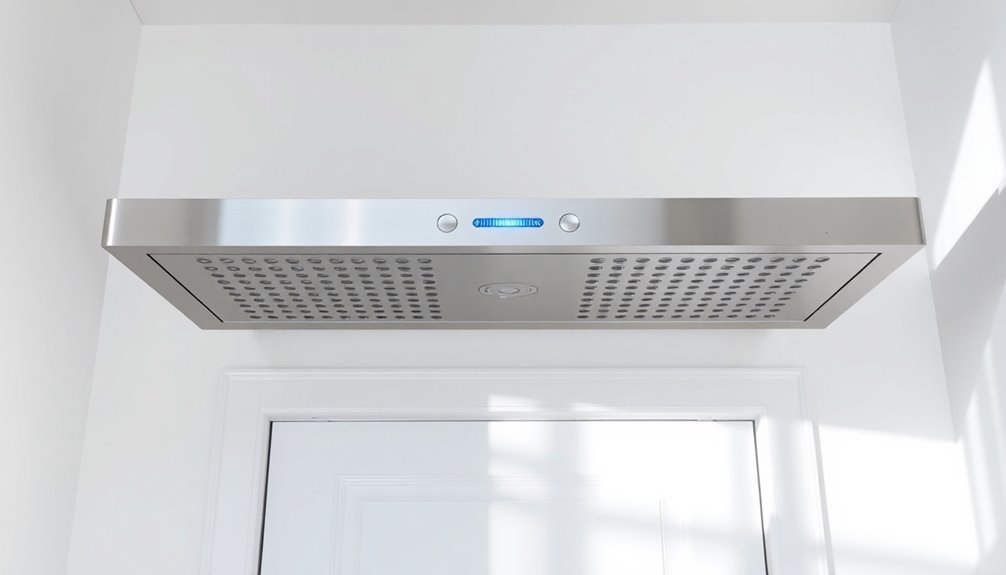
Proper installation of air ionization showers requires careful attention to both spatial and technical requirements. When planning your facility's layout, you'll need to accommodate standard dimensions, typically including 48 x 90-inch openings for doors and hardware.
You'll also want to guarantee sufficient clearance around the unit for maintenance access. Your air shower can be installed either protruding through walls or butted against existing walls with appropriate cutouts.
You'll need to coordinate with electricians for power connections and sprinkler contractors for necessary fire safety systems. The PLC control system ensures precise operational sequencing for optimal performance. The installation process includes sealing gaps with trim angles or caulk to maintain airtight integrity.
These modular units come pre-equipped with air filtration systems, blowers, and controls. You'll find they're constructed with cleanroom-compatible materials and feature clear anodized aluminum doors with tempered glass.
The closed-loop air recirculation system minimizes additional space requirements for air handling. Don't forget to take into account extra height requirements if you're opting for features like Constant Purge ceilings.
Remember that all installations must comply with local building codes, which may require specific disconnect switches or other safety features.
Maintenance Best Practices
Successful air shower maintenance requires a systematic approach to keep your system running at peak efficiency. You'll need to focus on regular filter inspections, proper cleaning procedures, and consistent safety protocols to maintain ideal performance.
Start by implementing a routine filter maintenance schedule. Check your pre-filters frequently and replace the non-woven fabric when necessary. Monitor HEPA filters for blockages and use dust particle counters to detect any leaks. When installing new filters, verify the arrow mark aligns with the airflow direction. Regular air velocity checks will help identify potential filter issues early on.
For cleaning, use industrial alcohol on stainless steel surfaces and avoid tap water, which can cause damage. Don't place your air shower in humid or dusty areas, as these conditions can compromise its effectiveness. Keep the surrounding area clean and dust-free to prevent contamination.
Train your personnel thoroughly on operational procedures and emergency protocols. They should understand how to use emergency stops and avoid opening doors during the air blowing cycle.
Check electronic locks regularly to prevent jamming, and conduct routine electrical circuit inspections. For complex maintenance issues, don't hesitate to call professional technicians who can properly diagnose and fix problems while maintaining your system's integrity.
Performance Testing Methods
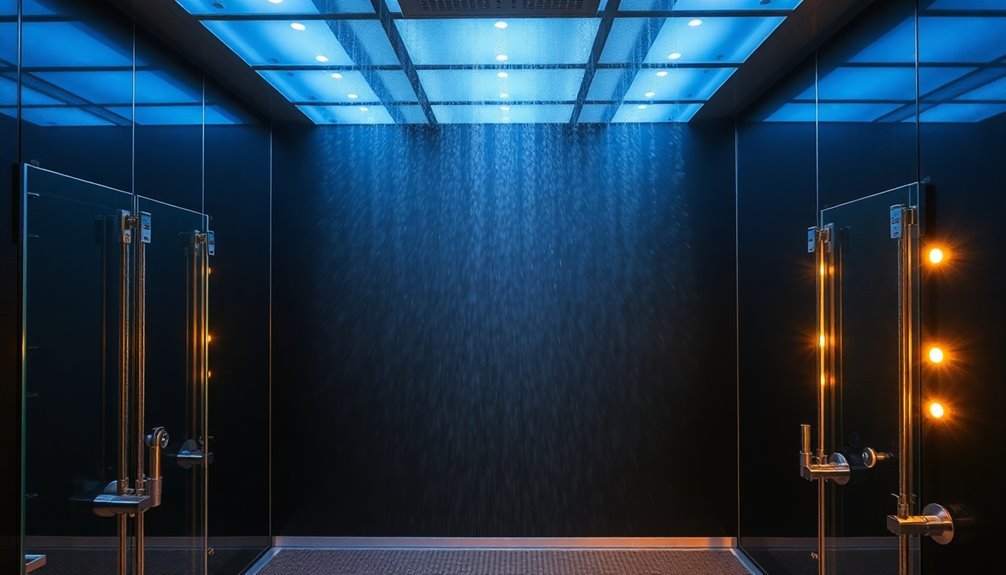
Testing air ionization showers requires precise measurement protocols and specialized equipment to evaluate their performance effectively. You'll need to verify proper calibration of particle counters and aerosol samplers before conducting any tests. The setup must include return air chase sampling and adjustable nozzles for ideal measurement conditions. Turbulent flow conditions must be carefully monitored during testing to ensure proper air distribution patterns.
To achieve reliable results, you'll want to maintain cycle times of at least 20 seconds, as this proves critical for particle removal efficiency. You should monitor airflow speeds carefully, aiming for 6,000 to 7,500 fpm with multiple impact points to prevent particle impregnation while verifying proper dislodging.
| Test Parameter | Measurement Standard |
|---|---|
| Particle Removal | ASHRAE 52-2 |
| Air Cleaner Rating | NORDTEST NT CONS 009 |
| Ionization Performance | ANSI/ESD STM3.1 |
| Efficiency Range | 35-90% |
| Cycle Duration | 20+ seconds |
For ideal testing outcomes, you'll need to implement real-time particle count technology and automatic exit control systems. Remember that garments used over multiple days require extended cycle times, and efficiency rates can vary considerably based on particle size and garment type. Regular performance monitoring using pulldown tests helps maintain consistent air shower effectiveness.
Safety Standards and Regulations
Four essential safety standards govern air ionization shower operations, with OSHA regulation 29 CFR 1910.151(c) and ANSI/ISEA Z358.1-2014 setting the foundational requirements.
You'll need to confirm your ionization shower meets the minimum flow rate of 20 gallons per minute and maintains tepid water temperatures between 60°F and 100°F to prevent user discomfort or injury.
When installing your air ionization shower, you must place it within a 10-second travel distance (typically 55 feet or less) from potential hazards.
It's critical to position the unit on the same level as work areas and provide adequate lighting for easy access during emergencies.
You'll also need to implement measures preventing unauthorized water supply shutoff and protect the system's components from airborne contaminants.
Your maintenance protocol should include weekly performance checks and annual thorough testing.
You're required to maintain detailed records of all inspections and repairs.
Don't forget to train your employees before they handle hazardous materials, confirming they understand proper shower operation and emergency procedures.
Remember that while ionization showers are essential safety equipment, they don't replace proper PPE and administrative controls in your facility.
Selecting Your Ideal System
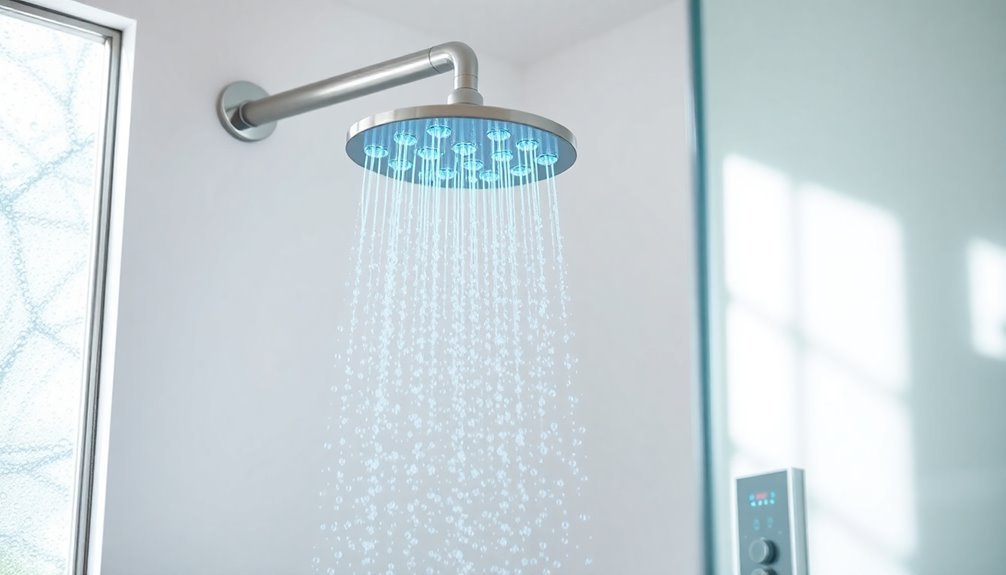
When you're ready to choose an air ionization shower system, you'll need to weigh the initial costs against the coverage area to guarantee peak performance for your space.
You should evaluate the power requirements and key performance features, including ion output levels and circulation rates, to match your specific air quality needs.
Based on your room's dimensions and layout, you'll want to follow space-specific installation guidelines to determine the ideal mounting location and configuration for maximum effectiveness.
Cost and Coverage Analysis
Selecting the right air ionization shower system requires careful consideration of both your budget and coverage needs.
You'll find single-person units starting at 2,000 yuan, making them ideal for small labs or limited-scale operations. For medium-sized facilities, double-person systems ranging from 5,000 to 8,000 yuan offer a practical balance between cost and capacity.
If you're managing a larger facility, you'll need to invest in multi-person systems starting at 8,000 yuan, or cargo shower rooms that can range from 10,000 to 20,000 yuan for high-configuration models.
Your material choice will considerably impact costs, with stainless steel offering superior durability but at a higher price point than standard steel options.
Don't forget to factor in long-term operational costs, including energy consumption, maintenance, and filter replacements. While the initial investment might seem substantial, it's relatively minor compared to the potential losses from contamination in sensitive environments.
Your choice of filtration system (HEPA or ULPA) and door configuration will also affect both the purchase price and ongoing maintenance costs.
Consider your facility's specific needs, cleanliness requirements, and throughput demands when making your final decision.
Power and Performance Features
Power features represent the backbone of any effective air ionization shower system. When you're selecting your ideal system, you'll want to focus on both energy efficiency and performance capabilities. TRINC's dense ionization technology delivers an impressive 92% dust removal rate while maintaining lower power consumption through high-efficiency fans.
| Feature | Benefit | Impact |
|---|---|---|
| Dense Ionization | 92% dust removal | Superior contamination control |
| High-Speed Processing | 3x faster than conventional | Increased productivity |
| Door-less Design | Continuous operation | Reduced energy waste |
You'll find that modern systems offer sophisticated control options, including touch-screen interfaces that let you monitor performance and manage alarms in real-time. For peak results, you should verify your system maintains air velocities between 6,000 to 7,500 fpm. The combination of HEPA filtration (99.97% efficiency) and strategically positioned air nozzles maximizes cleaning effectiveness while minimizing power usage. When evaluating performance features, consider that cycle times need to run at least 20 seconds, with longer durations for heavily contaminated garments. The door-less structure of advanced systems like TRINC's enables quick, continuous cleaning while maintaining energy efficiency.
Space-Specific Installation Guidelines
Proper installation requirements directly impact your air ionization shower's effectiveness, regardless of its power capabilities.
You'll need to position your unit at least 7 feet above the floor while maintaining specific clearances: 6 inches from the ceiling for wall-mounted units and 4 feet on the sides.
When selecting your installation location, avoid areas near HVAC exhaust inlets or negative pressure zones, which should be at least 4.5 times the width of your ionization unit away.
You'll want to take advantage of supply air outlets to achieve uniform ion distribution throughout your space. If you have ceiling fans, position the ionizer slightly below them for ideal air circulation.
Your installation environment must remain dry and well-ventilated. Don't install the unit in moisture-prone areas, as this can compromise performance and durability.
When mounting the unit, use appropriate anchors and screws, testing the installation with downward pressure to confirm stability.
For cleanroom applications, you'll need to take into account additional factors like nozzle placement and accessibility for maintenance.
Remember to verify that your chosen location allows for the recommended air velocity of 7,800 fpm and circulation rate of 1,900 cfm.
Cost Analysis and ROI
Making informed decisions about air ionization showers requires a thorough understanding of their costs and potential returns. The initial investment varies greatly based on your specific needs, with single-person units starting at 2,000 yuan and high-configuration cargo shower rooms reaching 20,000 yuan or more. Your choice of materials, door configurations, and specifications will directly impact the final cost.
While the upfront investment might seem substantial, you'll find considerable returns through various operational benefits. You'll save on maintenance costs as these systems protect your cleanroom environment and extend HEPA filter life. The high dust removal rates, particularly in advanced systems like the TRINC ION AIR-SHOWER KIT, translate to improved product quality and reduced defects in your production line.
When calculating ROI, consider that efficient air showers minimize downtime and reduce long-term operational costs. You'll experience fewer equipment replacements and maintenance needs due to better-controlled environments.
The durability of high-quality air showers means you won't face frequent replacement costs, and their contribution to maintaining cleanroom classifications helps prevent costly product defects and production losses.
Energy Consumption Considerations
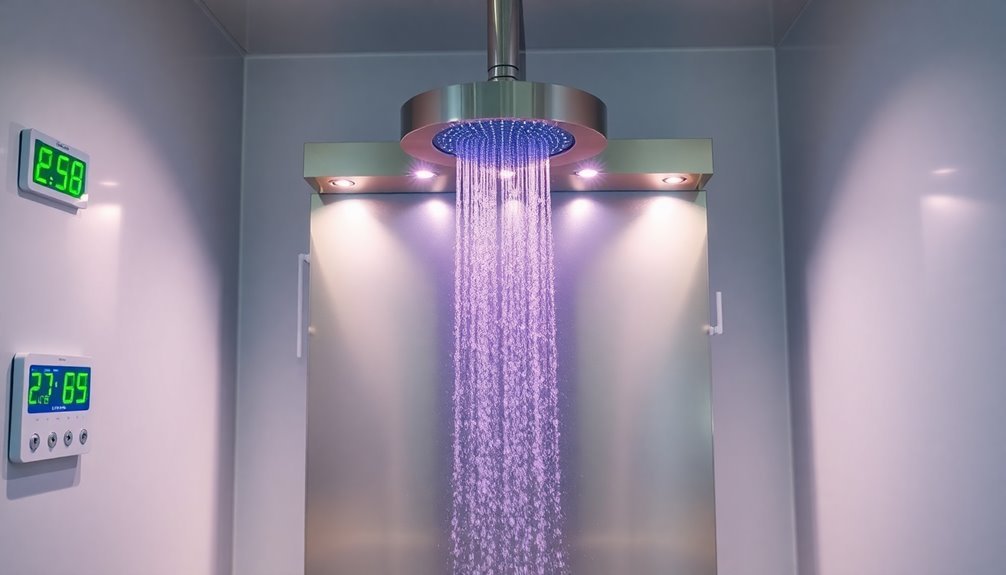
Understanding energy consumption is essential when implementing air ionization showers in your facility. You'll need to take into account multiple factors that affect your overall energy usage, with water temperature being the most crucial contributor – roughly twice as impactful as air temperature.
| Factor | Impact Level | Energy Saving Potential |
|---|---|---|
| Water Temp | Very High | 35-40% reduction possible |
| Flow Rate | High | Up to 35% savings |
| Air Temp | Medium | 15-20% reduction |
| Ventilation | Low | 5-10% enhancement |
To enhance your energy consumption, you'll want to focus on implementing efficient technologies like air-powered shower systems, which can reduce energy usage by up to 60% compared to traditional setups. These systems use less water while maintaining comfort through air-injection technology. You should maintain water temperatures within the thermal neutral zone (33.5–35.7°C) and air temperatures between 30.8–34.9°C for peak efficiency.
Think about installing low-flow devices that incorporate advanced technologies like Oxijet, which uses air to maintain pressure sensation while reducing water consumption. By combining these strategies with proper ventilation and energy-efficient heating systems, you'll greatly decrease both energy costs and environmental impact.
Common Applications and Industries
You'll find air ionization showers widely used in healthcare facilities, where they help maintain sterile environments and protect both patients and medical staff from airborne contaminants.
In commercial office spaces, these systems work to improve indoor air quality and create healthier work environments for employees.
The hospitality and food service industry also relies on air ionization technology to guarantee clean air in dining areas and food preparation zones, meeting strict health and safety regulations.
Healthcare and Medical Facilities
Air ionization technology plays an essential role in modern healthcare facilities, where maintaining sterile environments and controlling airborne contaminants is imperative for patient safety. You'll find these systems implemented throughout medical facilities, particularly in critical areas like operating rooms and patient isolation spaces, where they effectively disable airborne pathogens and reduce cross-contamination risks.
In healthcare settings, you can rely on air ionization showers to enhance infection control by decreasing bacterial deposition on surfaces while inactivating airborne bacteria, viruses, and fungi. These systems work continuously to improve indoor air quality and substantially reduce particle counts in cleanroom environments.
When you're dealing with sensitive medical procedures, the technology helps maintain sterile conditions by generating both positive and negative ions that purify the air.
If you're managing a healthcare facility, you'll appreciate that many ionization systems require no maintenance for their entire lifespan. They're particularly effective when integrated with existing HVAC systems, and fixed units typically deliver better results than portable options by ensuring proper room air mixing and consistent airflow patterns.
This technology proves especially valuable in long-term applications, where it consistently removes airborne particles and VOCs.
Commercial Office Spaces
Beyond healthcare settings, commercial office spaces have rapidly embraced air ionization technology as a proven solution for indoor air quality. You'll find this technology particularly effective in reducing airborne contaminants by up to 99.9%, making it an excellent choice for property owners looking to protect their tenants and employees.
Columbia Property Trust's portfolio-wide implementation demonstrates how you can successfully integrate bipolar ionization systems into various office environments. These systems require minimal maintenance, with ion tubes needing replacement only every two years, making them cost-effective for long-term use. You can install them in your building's air handling units or smaller spaces like elevator cabs.
When you're considering air ionization for your commercial space, you'll benefit from its adaptability regardless of your office size. The technology combines naturally occurring chemistry with optional features like medical-grade HEPA filtration and UVC sterilization.
You won't need to worry about safety concerns, as the system doesn't produce harmful by-products like ozone. For ideal results, you'll want to maintain proper commissioning and follow ASHRAE recommendations to guarantee long-term effectiveness in particle reduction and improved indoor air quality.
Hospitality and Food Service
Leading hotels and restaurants have turned to air ionization technology as a cornerstone of their indoor air quality strategy. Luxury brands like Ritz Carlton, Marriott, and Four Seasons have integrated bipolar ionization systems into their existing HVAC infrastructure, achieving up to 91.3% reduction in airborne pathogens.
You'll find these systems working silently throughout hotels, from guest rooms to dining areas, fitness centers, and public spaces.
In hospitality settings, you won't just benefit from cleaner air – you'll experience extensive protection across multiple touchpoints. The technology effectively eliminates cooking odors, reduces surface bacteria, and maintains consistent air quality in high-traffic areas like reception desks and conference rooms.
- Feel confident knowing your hotel room's air is actively purified while you sleep
- Breathe easier in restaurant spaces where cooking odors are neutralized instantly
- Exercise safely in hotel fitness centers with reduced airborne pathogens
- Enjoy peace of mind during conferences with continuous air purification
The integration of ionization technology with existing HVAC systems makes it a practical choice for hospitality venues, offering both immediate and long-term benefits for guests and staff alike.
Frequently Asked Questions
Can Ionization Showers Be Used Simultaneously by Multiple People?
Yes, you can use ionization showers with multiple people at once. They're available in tunnel designs that accommodate several users simultaneously, making them efficient for large groups during shift changes or high-traffic periods.
Do Air Ionization Showers Affect Electronic Devices Carried Through Them?
Yes, air ionization showers can affect your electronic devices. You'll want to properly shield or avoid carrying sensitive electronics through them, as the high voltage and ionized particles may cause damage or malfunction.
How Long Should Someone Stay in an Ionization Shower for Optimal Results?
You'll need to stay in the ionization shower for at least 20 seconds, though 30 seconds is ideal. If you're wearing garments used for more than a day, you might need longer exposure time.
Are Ionization Showers Safe for People With Pacemakers or Medical Implants?
You shouldn't use ionization showers if you have a pacemaker or medical implant. The electromagnetic fields they generate can interfere with your device's operation. Always consult your doctor before using any ionizing equipment.
Can Ionization Showers Remove Chemical Residues From Protective Clothing?
You can't fully rely on ionization showers to remove chemical residues from protective clothing. While they may help with some particles, they're not consistently effective. It's better to use specialized cleaning methods instead.
In Summary
You'll find air ionization showers to be a worthy investment for maintaining clean environments, despite the initial costs. Consider your specific requirements for space, maintenance, and energy consumption before making a final choice. Whether you're operating a cleanroom, medical facility, or manufacturing plant, these systems will provide reliable contamination control when properly selected and maintained. Regular performance testing guarantees peak results.

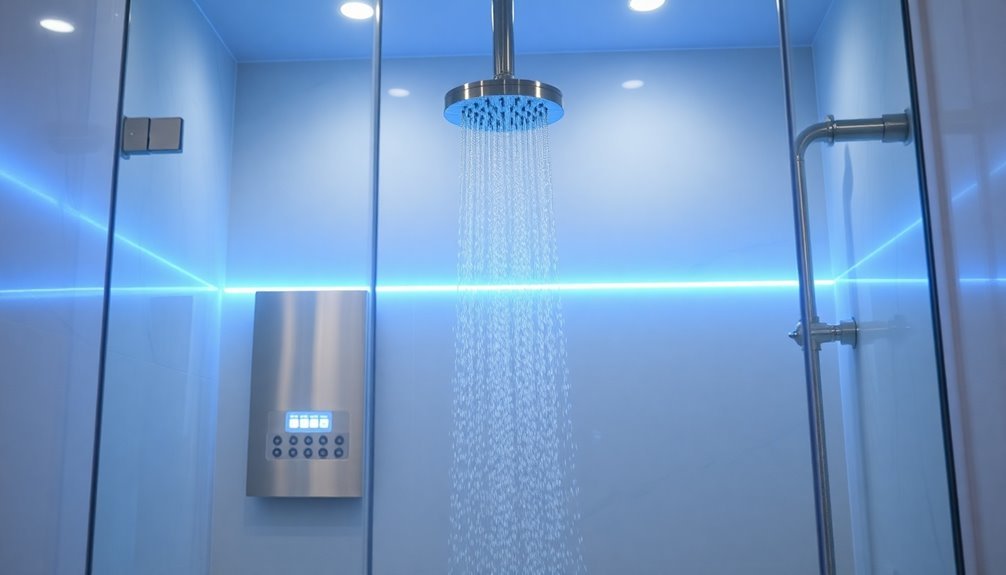



Leave a Reply